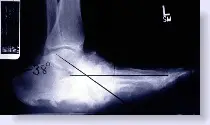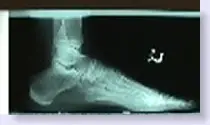Charcot foot
AUTHOR: Marc Mitnick DPM
home --> Charcot foot
Charcot osteoarthropathy or neuropathic joint disease
WHAT IS CHARCOT FOOT
This condition, also known as charcot osteoarthropathy or neuropathic joint disease is a chronic, progressive and destructive process that affects the bones and joints of the foot.
CHARCOT FOOT CAUSES
Jean-Martin Charcot was a French neurologist who in 1868 first recognized the association between neurological disease and the resulting bone and joint destruction in the lower extremities. During this period the relationship was between tabes dorsalis (neurosyphillis) and the destruction to the joints in the feet.
Today, in the industrialized world diabetes is the number one cause of Charcot foot. Other causes include alcoholic neuropathy, cerebral palsy, leprosy, multiple sclerosis, rheumatoid arthritis, pernicious anemia, lyme disease and spinal cord injury.
The problem is due to lack of proprioception, the inability to ‘feel’ the ground that you are walking on. A good example of proprioception is seen when walking on a rocky terrain such as a gravel driveway. As your foot comes down on a rock sticking out of the ground, your brain recognizes the fact that the foot is not going to come down properly on the ground (due to the rock) and you are able to make adjustments in order to keep walking forward. With any neuropathy (loss of sensation to the feet), the connection is not made between the feet and the brain, the feet do not adjust properly and there then becomes excessive strain placed on the joints and bones of the foot. Over time these joints and bones begin to break down.
Below is an x-ray of a Charcot foot deformity on the left. Compare it with the x-ray of a normal foot on the right. The pathological changes should be apparent even to the untrained eye. Note the loss of the arch and all the bone destruction that has occurred where the arch was once located.

|

|
STAGES OF CHARCOT FOOT PROGRESSION
The Charcot foot disease process is generally broken down into three stages.
Stage 1 is the acute destructive stage, which is typically characterized by profound swelling of the foot, increased temperature and increased redness, actually due to increased circulation to the foot, which often mimics infection. X-rays taken at this point can be negative but more commonly demonstrate soft tissue edema, joint effusion (swelling within the joints), joint subluxation (bones do not line up properly to each other) and formation of bone fractures and fragmentation. In spite of all this, the foot may not be painful.
The acute stage is the most critical in terms of treatment. In other words, the earlier treatment is initiated, the less damage that will result.
Stage 2 is often referred to as the sub-acute stage. Evidenced during this stage is reduced, edema, reduced temperature and redness and the absorption of the bone and cartilage fragments along with healing of any fractures.
Stage 3 is then referred to as the chronic stage. The body trying to further remodel the foot, in an effort to stabilize the foot and restore joint and bone function, characterizes this stage. The problem here is that the damage has already been done.
Charcot foot fracture and ulcer
The ‘damage done’ consists of a foot that no longer functions in a normal gait cycle. Because of the abnormal shape of the foot due to breakdown and fracture, there is usually excessive pressure points on the skin that will eventually breakdown and ulcerate out. (see my discussion on the diabetic foot and Charcot disease.) Since an ulcer is an opening in the foot it is subject to infection. Even if it does not become infected, the ulcer itself can take months, if not years, to finally close. If it does become infected you risk invasion of the bacteria into the bone resulting in an osteomyelitis (bone infection) and possible amputation. Because Charcot foot is seen more so in patients with neuropathy, elevated blood sugars and usually poor circulation it is not uncommon for the above scenario to play out.
CHARCOT FOOT PREVENTION
Early detection and treatment is the key to avoiding excessive damage. A common theme of mine in this site is for diabetics to have a proactive approach in the care of their disease, meaning, making all efforts to control their blood sugar, because even though you may feel fine, if your blood sugars are continually elevated you are doing damage to yourself on a daily basis.
Inspecting your feet regularly. In the case of suspected Charcot foot, should you notice a difference between your two feet, (as this condition usually only occurs in one foot) such as one foot is more swollen, warmer to touch or more red than the other foot, this should be brought to the immediate attention of your doctor.
regular medical check ups from both your medical doctor and podiatrist.
Charcot foot orthotics wearing a good orthotic on a regular basis goes a long way to prevent the slow, gradual breakdown of the joints in the foot.
CHARCOT FOOT TREATMENT
CASTING AND IMMOBILIZATION Treatment consists of immobilization and if possible non-weightbearing on the affected foot in an effort to curtail any further destruction. We use what is known as a total contact cast which is cast or boot that is molded to the bottom of the foot to provide even distribution of body weight over the entire bottom of the foot and therefore to create even pressure on the foot to prevent further breakdown.
Depending on the acuteness of the stage and other factors such as inadequate blood sugar control, obesity and patient compliance, total contact casting may be necessary any where from six weeks to several months.
MEDICATION In addition to immobilization a class of drugs known as biphosphanites (Pamidronate) are being used intravenously to help heal the bone fractures that occur. Medication would be used during the first two phases of the disease.
BONE STIMULATORS In addition to medication, there has been some experimentation with bone stimulators to also heal the pathological fractures that occur. This would also be indicated during the first two phases of Charcot foot.
MOLDED SHOES Treatment for the end result of the damage done usually requires special shoes that are molded to the newly deformed foot in an effort to protect bony protrusions and to prevent further breakdown. Even though the inflammatory part of the disease has diminished, we now are left with a poorly functioning foot which in itself is subject to further breakdown.
SURGERY If there are parts of the foot that are left severely deformed many times surgical intervention will be indicated in an effort to remove any excess bony prominences and to fuse any weakened joints to prevent further degradation of the foot. Most of the resulting problems are located on the bottom of the foot.
REFERENCES
Want more information? CLICK HERE


Recent Articles
-
Vitamin D impact on health
Feb 06, 23 07:17 PM
Researchers are suggesting that the effectiveness of Vitamin D in fighting and preventing disease is predicated on a persons body mass index (BMI). The thinner the person the greater the positive impa… -
Foods to speed up healing
Feb 01, 23 02:41 PM
One of the best ways to help yourself heal faster after surgery is to eat well. Getting the proper nutrition will provide your body with the essentials it needs to promote healing. Here is a suggestio… -
Cancer and Type 2 Diabetes
Jan 25, 23 04:52 PM
An article revealing that older type 2 diabetics have a higher incidence of cancer then non-diabetics. It is suggested that cancer may surpass CVD as the number one cause of death in older diabetics. -
Does glucosamine or MSM reduce arthritis pain?
Jan 22, 23 01:41 PM
A good review of the possible benefits to taking glucosamine, chondroitin or MSM for arthritis. Always beware of the possible side effects of over the counter supplements. -
shin splints
Jan 18, 23 05:12 PM
A great review on the various causes of shin splints, along with treatment options. -
Whats new in skin cancer?
Jan 15, 23 08:32 PM
A presentation of newer skin protection combinations in an effort to better protect the skin from the hazards of sun exposure. -
Causes and risk factors of warts
Jan 14, 23 05:02 PM
A good review of the causes of warts and protective measures you can take to prevent developing them. -
Do chronic wounds need to be dressed daily?
Jan 11, 23 02:18 PM
Because of supply chain shortages as well as staffing shortages particularly during the pandemic, many institutions extended the time between dressing changes for chronic wounds. Is this really the be… -
Food choices that raise your risk of type 2 diabetes
Jan 08, 23 10:07 AM
A good review of how blood sugars can become elevated and the harm that can do. Certain food groups have a tendency to raise your blood sugars and should be avoided. -
Outcome stats from Scarf bunionectomy
Jan 03, 23 03:04 PM
The Journal of Foot and Ankle Surgery recently reported a meta analysis of outcomes in 1583 Scarf bunionectomies that met their inclusion criteria. Adverse events did not seem to be any better or wors…